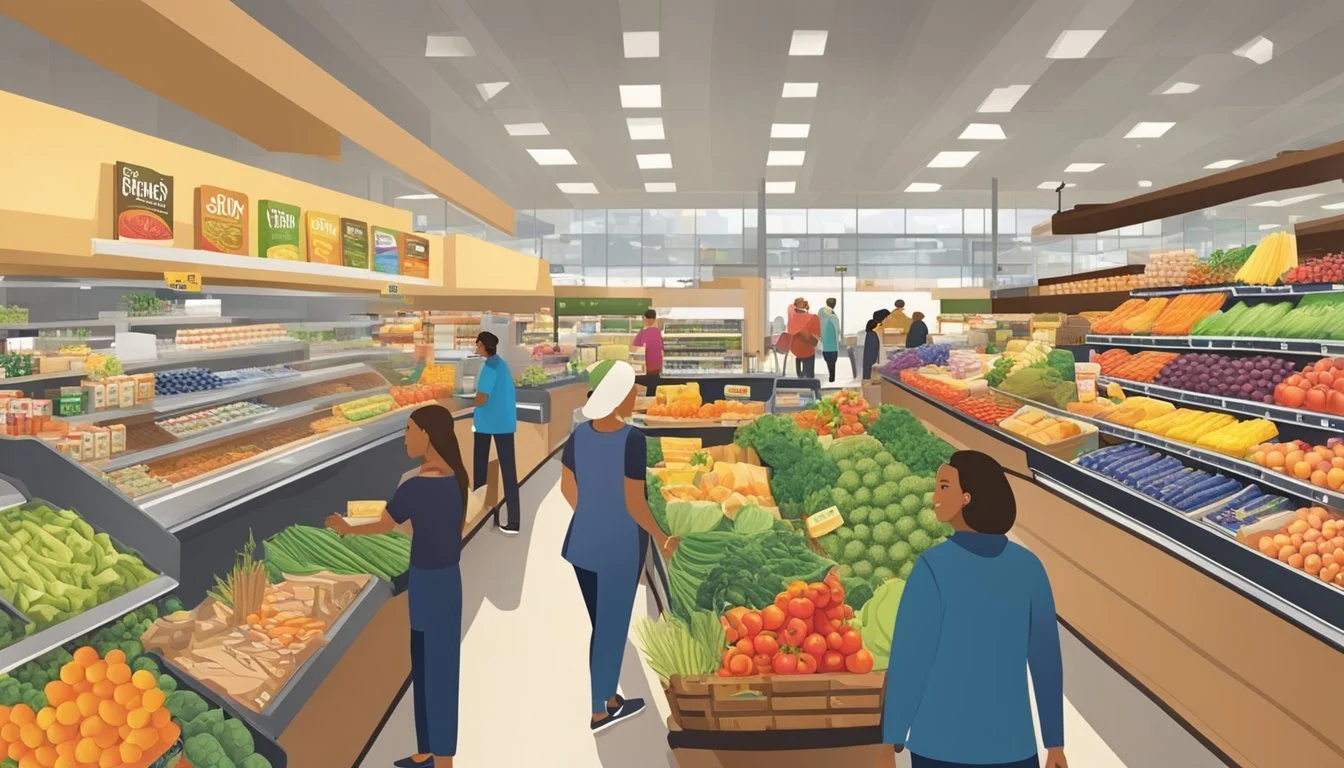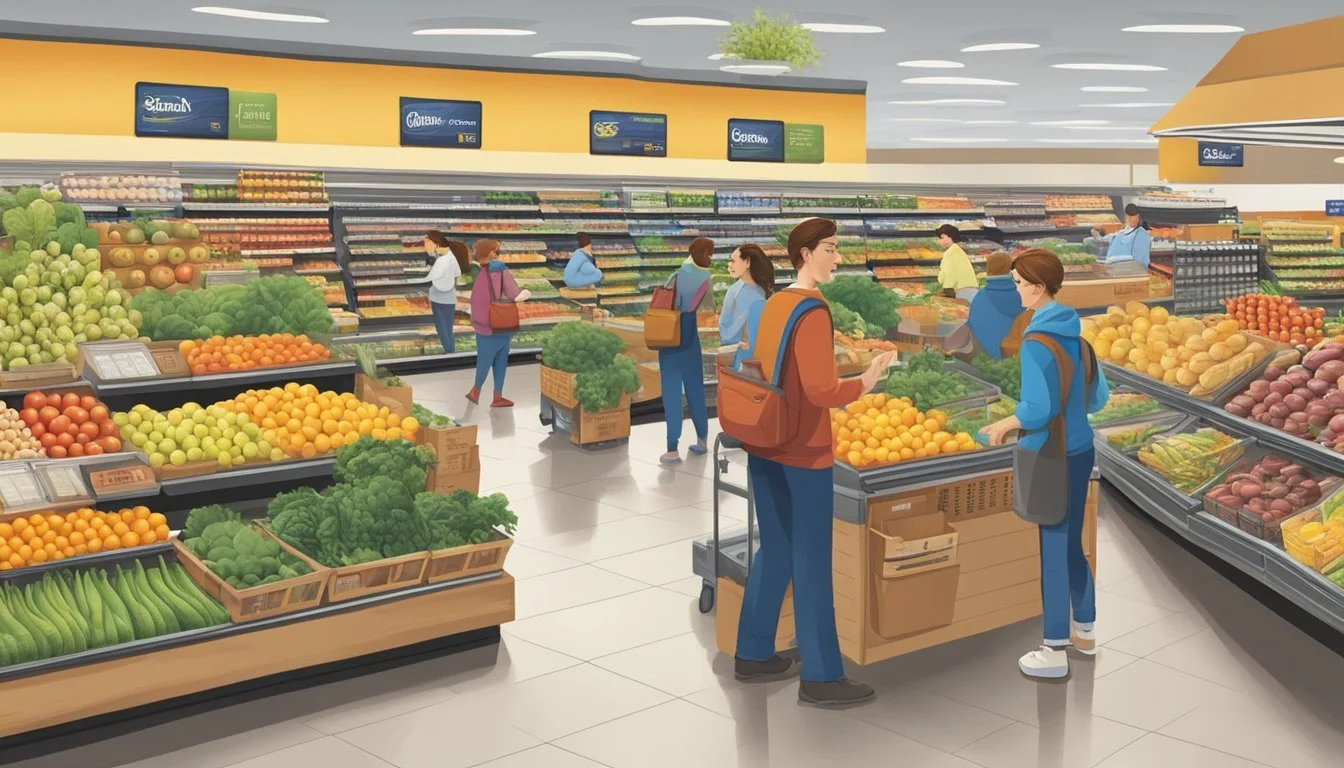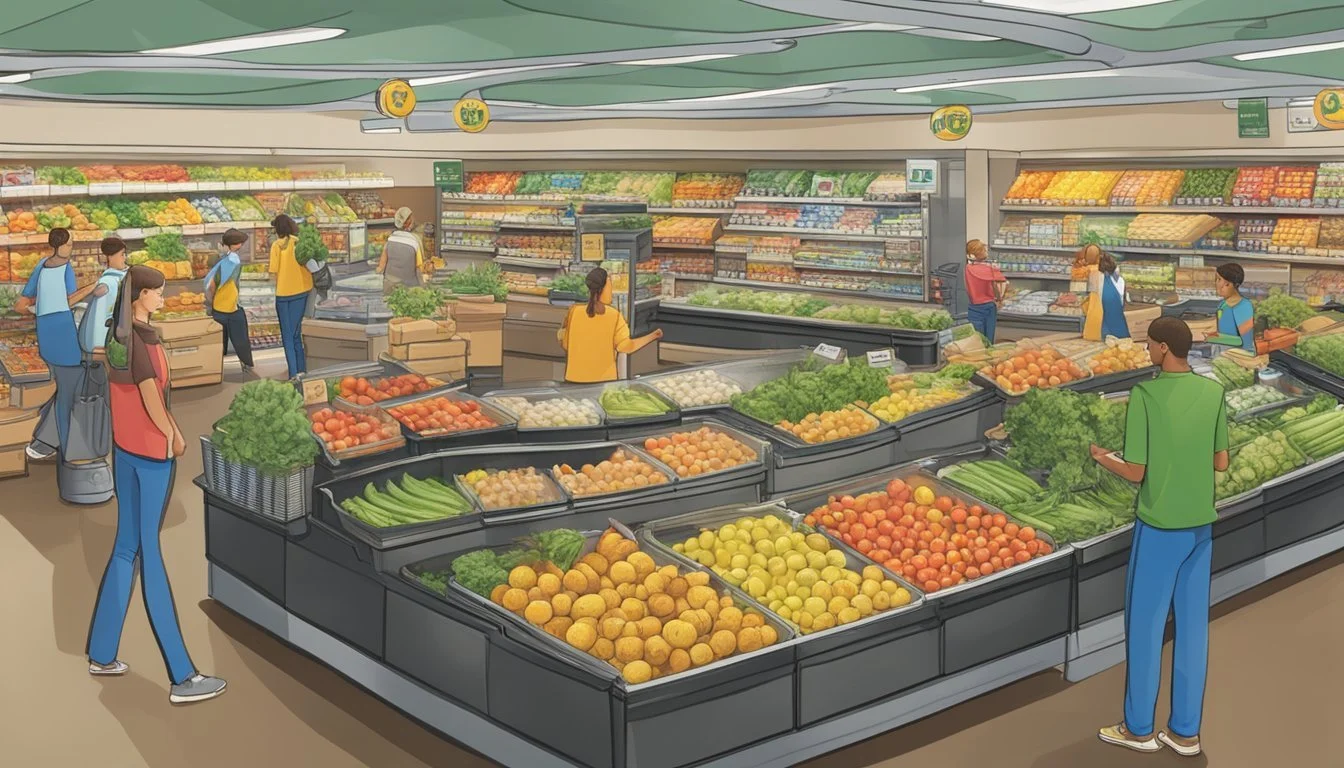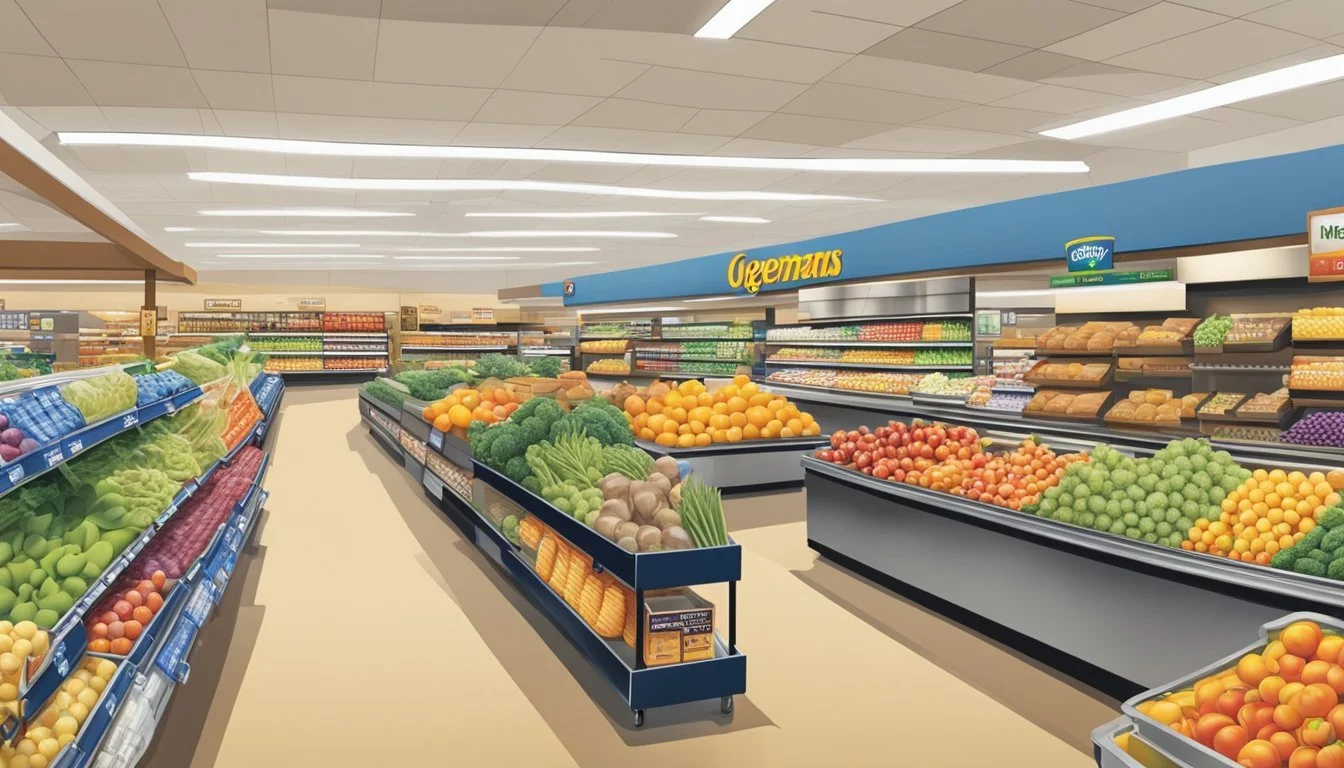Wegmans vs Lidl
Comparing Shopping Experience, Prices, and Product Quality
When grocery shopping, consumers are faced with a variety of choices regarding where to purchase their goods. Among these options, Wegmans and Lidl stand out as prominent grocery stores widely recognized for their distinct shopping experiences. Wegmans, which has developed a strong regional presence, especially in the Northeast, is known for its wide range of products, commitment to customer service, and community-focused approach. Originating from a family business, it has built a reputation for offering an extensive selection of both brand-name and private label products alongside in-store dining options.
On the other hand, Lidl, a relative newcomer to the United States with roots in Germany, represents a growing force in the grocery industry following a business model similar to that of its counterpart Aldi. With a focus on efficiency and a no-frills shopping environment, Lidl provides customers with high-quality products at consistently low prices. The store's layout is designed to simplify the shopping process, often featuring a smaller overall footprint than a typical Wegmans, but with a strong emphasis on value for money, especially in staple categories.
Choosing between Wegmans and Lidl ultimately depends on the priorities of the shopper. While Wegmans offers a more diverse array of goods and a larger store experience, Lidl attracts those looking for streamlined shopping trips with an emphasis on savings. As these two grocery chains continue to expand, they offer consumers distinct takes on the concept of the modern grocery store, each with its own approach to customer satisfaction and value.
History and Background
Wegmans began its journey in Rochester, New York, in 1916 as a fresh produce pushcart and has since evolved into a beloved regional supermarket chain. Known for its vast selection and specialty departments, Wegmans maintains a significant presence along the East Coast, including in states like New York, Pennsylvania, New Jersey, Delaware, Maryland, Massachusetts, Virginia, and North Carolina. As a family-owned company, Wegmans places high value on customer service and community engagement, which has translated into a dedicated customer base.
On the other hand, Lidl, established in 1973 in Germany, expanded aggressively and entered the international market, with stores now spread across Europe and the United States. Lidl made its debut on the East Coast in 2017 and continues to grow, with a focus on Virginia, North Carolina, and recently Delaware and Washington D.C. Unlike Wegman's century-long history in the United States, Lidl is a relative newcomer in the American grocery market. Nevertheless, Lidl has quickly established itself as a key player in the regional grocery landscape, known for its discount prices and efficient store design.
Here’s a brief comparative overview:
Aspect Wegmans Lidl Founded 1916 1973 Origin New York, United States Germany Expansion New York, Pennsylvania, and other states on the East Coast Virginia, North Carolina, Delaware, Washington D.C, and more Focus Customer service, variety Discount pricing, efficiency
Both Wegmans and Lidl have carved out niches on the East Coast, catering to different market segments through their individual brand philosophies. Wegmans emphasizes quality and customer experience, while Lidl focuses on affordability and simplicity.
Store Locations and Accessibility
When considering Wegmans and Lidl, shoppers notice significant differences in their geographic distribution and the ease of finding a store. Each brand has a strategy that reflects its history and market goals.
Wegmans' Presence
Wegmans is a regionally focused chain with a strong presence in the Northeastern and Mid-Atlantic regions of the United States. Wegmans stores are typically larger and offer a variety of amenities. As of now, they operate in states like New York, Pennsylvania, New Jersey, Virginia, Maryland, Massachusetts, and North Carolina. The brand is known for its thoughtful store design and a wide selection of grocery staples.
Number of Stores: Wegmans operates about 106 stores across the regions mentioned.
Store Size: Large, ranging from 75,000 to 140,000 square feet.
Lidl's Expansion
Lidl, on the other hand, is a relative newcomer to the U.S. market but is expanding rapidly. This European-based discount grocery chain has opened stores along the East Coast, with plans to continue growing. Lidl's stores are smaller than Wegmans but they are designed for efficient shopping with high-quality products at very competitive prices.
Number of Stores: Hundreds of stores across Europe and a growing presence in the United States with over 150 stores.
New Markets: Lidl is breaking into the Northwest market, juxtaposed to Wegmans, indicating aggressive expansion strategies.
Store Size: More compact, averaging around 20,000 square feet.
Product Range and Quality
Wegmans and Lidl both offer unique shopping experiences, with a diverse range of products and emphasis on quality, particularly when it comes to fresh and organic produce, meats, and store brands.
Wegmans' Offerings
Wegmans is renowned for its extensive product selection, including a wide array of store brands that are often compared to national brands in terms of quality. They offer a significant variety of organic produce and are noted for the quality of their fresh produce and meats. Shoppers can find a vast selection of items ranging from the essentials to gourmet and international foods, catering to those interested in whole foods, vegan options, and specialized diets. Their commitment to quality is evident in their fresh, well-maintained produce sections and their comprehensive offerings of both everyday and specialty items.
Lidl's Selection
Lidl provides a competitive selection with a focus on cost-effectiveness without compromising on quality. Their store brands are recognized for their affordability and are a strong draw for cost-conscious consumers. Lidl's selection covers a wide scope, including fresh produce, quality meats, and household necessities. They are increasing their range of organic and vegan products to align with consumer trends toward health-conscious shopping. While their product range may not be as extensive as Wegmans', Lidl excels in offering a curated selection that balances quality and value, often showcasing a rotation of unique and seasonal items.
Pricing and Affordability
When it comes to pricing, both Wegmans and Lidl have distinct strategies that cater to different market segments. Wegmans is known for offering a wide array of products, while Lidl's focus on price competitiveness aims to provide customers with substantial savings.
Wegmans' Pricing Strategy
Wegmans is not typically recognized for being the least expensive option on the market. Instead, they provide a diverse product range, including premium and organic products, that can influence overall prices. Wegmans' prices may be compared with stores like Whole Foods, an establishment known for its higher price point but also for its quality. Consumers shopping at Wegmans can expect a broad selection, which can include high-end options often priced higher than the average grocery store items.
Lidl's Price Competitiveness
Lidl, on the other hand, has a pricing strategy that focuses on affordability. With prices that are significantly lower than the all-store average, Lidl's approach to pricing is aggressive. They aim to attract consumers looking for savings without compromising on quality. Recent surveys have indicated that Lidl's prices can be 36 percent lower than the all-store average. This positions Lidl closely to Aldi, another discount grocer known for its exceptional value. It is important to note that Walmart is often cited as having the lowest prices among most U.S. grocery chains, which sets a strong benchmark for Lidl's pricing competitiveness.
Customer Service Experience
In evaluating the customer service experience at Wegmans and Lidl, shoppers often highlight staff interaction and customer assistance as defining factors for their overall satisfaction with each store. Surveys and customer feedback play a crucial role in understanding the service quality at these grocery chains.
Staff Interaction at Wegmans
At Wegmans, customers frequently report a high level of staff helpfulness and courtesy. The employees are known for their knowledge about products and are often praised for their prompt service. Wegmans has cultivated a reputation where staff interaction elevates the shopping experience beyond mere transactions, creating a friendly and welcoming environment as reflected in customer surveys and feedback.
Customer Assistance at Lidl
Lidl's approach to customer service centers around efficiency and practicality. The staff at Lidl is often recognized for being quick to assist customers in finding items, but there might be fewer opportunities for in-depth interaction due to the store's more streamlined and self-service layout. Nonetheless, Lidl customers appreciate the fast checkout and simple store navigation, suggesting a different but equally valued aspect of service.
Store Brand Versus National Brands
In comparing Wegmans and Lidl, a key consideration for consumers is the value proposition offered by each store's brand products versus national brands. Store brands are typically positioned as cost-effective alternatives to national brands while aiming to match or exceed their quality.
Wegmans' Store Brand
Wegmans boasts a wide array of in-house brand products that span across different categories, from pantry staples to ready-to-eat meals. Wegmans store brand items claim to save shoppers roughly 40% compared to national brands, without compromising on quality. Customers frequently purchase Wegmans brand items for their perceived taste and quality, which often equal or surpass their branded counterparts.
Savings: Approximately 40% less than national brands
Product Range: Extensive, including staple items and specialty products
Quality: Comparable or superior to national brands, based on consumer feedback
Lidl's Private Labels
Lidl operates with a heavy emphasis on private labels, carrying a limited selection of national brands to focus on their own labels. Lidl's private labels offer shoppers significant savings, with many products priced up to 50% lower than national brand equivalents. Lidl's private label items cover both common grocery items and seasonal specials, often highlighting their European heritage in the quality and flavor profiles of their offerings.
Savings: Can be up to 50% more affordable than competing national brands
Product Range: Wide, with a focus on European products and flavors
Quality: Designed to compete with national brands, often with a European twist
Shopping Atmosphere and Design
When visiting a supermarket, customers often place significant value on the store's atmosphere and design. These aspects enrich the shopping experience, beyond just the basics of product availability.
The Ambiance of Wegmans
Wegmans is well-known for its warm ambiance, resembling a European open-air market. Customers are welcomed by the sight of a bountiful produce section and an array of freshly prepared foods. Each store meticulously integrates cozy lighting and thoughtful layout, contributing to a sense of community and comfort. This holistic approach is designed to make shopping an enjoyable activity rather than a monotonous chore.
Lidl's Store Layout
Lidl, on the other hand, embraces a no-frills layout focusing on efficiency and simplicity. The stores are laid out in a straightforward, easy-to-navigate design that prioritizes product accessibility. With wide aisles and clear signage, Lidl ensures customers can easily find what they need, which is a hallmark of their practical approach. The uncomplicated and direct store format typically leads to quicker shopping trips, aligning with the needs of customers who favor convenience.
Additional Services Offered
When comparing Wegmans and Lidl, the range and quality of additional services each store offers play a significant role in the overall shopping experience. Both stores have differentiated themselves by providing unique conveniences to meet the needs of their customers.
Wegmans' Extra Features
Wegmans stands out for its extensive range of prepared foods and a variety of subs and meals that cater to busy shoppers looking for quick and delicious options. They offer a robust delivery service, ensuring shoppers can receive their groceries without stepping foot in the store. Wegmans also facilitates curbside pickup, which adds a layer of convenience for customers on the go. This service, however, may be subject to an annual fee depending on the customer's subscription plan.
Delivery: Available with a subscription fee.
Curbside Pickup: Offered, with potential annual fee depending on subscription.
Prepared Foods and Subs: Wide selection, focusing on convenience and quality.
Conveniences at Lidl
Lidl provides customers with expeditious checkout options, which streamline the shopping process and enhance the overall efficiency of their visits. Additionally, Lidl occasionally offers curbside pickup, although this service is not as established or consistent as it is at Wegmans. While Lidl may not have the same extensive range of prepared food options, it competes by providing quality products at a lower cost, targeting value-conscious consumers.
Checkout: Efficient and fast to minimize wait times.
Curbside Pickup: Limited availability compared to Wegmans.
Prepared Foods: Available but with a more limited selection.
Consumer Loyalty and Satisfaction
When comparing Wegmans and Lidl, consumer loyalty and satisfaction emerge as critical factors that differentiate the two grocery store chains. These aspects often reflect the quality of services, range of products, and overall shopping experience.
Wegmans' Loyal Following
Wegmans has cultivated a strong loyal following, with high marks in customer satisfaction surveys. Customers often cite Wegmans' friendly staff, clean stores, and a diverse selection of goods, including organic and locally-sourced options, as reasons for their allegiance. Wegmans consistently rates high on surveys, such as those from Consumer Reports, cementing its reputation as a beloved regional grocer with a commitment to quality and service.
Satisfaction Levels with Lidl
Lidl, on the other hand, is recognized for affordability and efficient store layouts, which resonate well with budget-conscious shoppers. Lidl's satisfaction levels are reinforced by its competitive pricing and private label products that offer lower prices without compromising quality. As a relative newcomer in some markets, Lidl is still building its brand, but early surveys indicate a growing satisfaction among its customer base, appreciating the value proposition it offers.
Comparison of Operational Efficiency
When assessing the operational efficiency of grocery stores, the utilization of technology and supply chain management are crucial for Wegmans and Lidl. These factors not only influence cost savings but also the consistency of product availability and overall customer satisfaction.
Wegmans' Supply Chain Management
Wegmans is recognized for its effective supply chain management. It invests heavily in technology to streamline its operations, from procurement to product delivery. Inventory tracking systems and predictive analytics allow for real-time insights, enabling Wegmans to reduce waste and ensure a consistent supply of products. They maintain a strong relationship with suppliers, using a centralized distribution strategy that minimizes the time between an item leaving the farm or factory and arriving on store shelves.
Centralized distribution
Real-time inventory tracking
Lidl's Supply Efficiency
Lidl, on the other hand, follows a lean supply chain model, focusing on cost efficiency and a smaller product range. These practices allow Lidl to operate with high efficiency and pass savings on to the customer. Lidl employs a just-in-time inventory approach, supported by a robust IT infrastructure, which minimizes overstocking and reduces storage costs.
Lean supply chain model
Just-in-time inventory approach
Impact of Market Dynamics
The competitive landscape of the grocery industry is noticeably influenced by broader market dynamics such as inflation and the lingering effects of the pandemic. These forces have modeled consumer behavior as well as grocery store strategies.
The Influence of Inflation
Inflation impacts both consumers and grocery stores like Wegmans and Lidl. Wegmans, a conventional supermarket chain, may experience a shift in consumer purchasing patterns as shoppers become more price-sensitive. In contrast, Lidl, with its discount pricing model, could attract a larger customer base looking to stretch their dollar further. The all-store average for groceries tends to rise during inflationary periods, prompting customers to seek out stores that offer better value for money.
Effects of the Pandemic
The pandemic has triggered significant changes in the grocery sector, with many stores adapting to new shopping habits. Supermarkets faced unprecedented challenges in supply chain management and in-store safety. Wegmans, known for quality, had to balance maintaining high standards with the increased demand for value. Meanwhile, Lidl appealed to those concerned with economic constraints, potentially increasing its market share as shoppers prioritized low costs over premium experiences. The pandemic's influence persists, shaping how both stores strategize to meet evolving consumer needs.
Environmental and Social Responsibility
When examining the environmental and social responsibility of grocery stores, both Wegmans and Lidl have made significant efforts. Their initiatives are designed with sustainability and community impact at the forefront, demonstrating a commitment to corporate responsibility and positive environmental action.
Wegmans' Sustainability Initiatives
Wegmans has implemented a comprehensive sustainability strategy. The company's zero-waste initiative, which aims to eliminate all forms of waste, has notably increased their average store recycling rate. Starting from a single-store pilot in 2016, it has expanded to a majority of their locations. By 2022, Wegmans had successfully increased its store recycling rate from 62% to 80.3%. This commitment not only reduces landfill contributions but also underlines the corporation's dedication to sustainable resource management.
Lidl's Community Impact
Lidl US has demonstrated corporate responsibility through the release of its first Corporate Social Responsibility (CSR) Report. This document details Lidl’s environmental and social initiatives over the last two years, focusing on how the company is integrating sustainability into its operation. The report indicates Lidl's intent to address and reduce environmental impacts through various measures, demonstrating an ongoing investment in community well-being and sustainable business practices.
Online Presence and Digital Strategy
In the competitive landscape of grocery retailers, digital strategy and online presence are crucial for engaging customers and driving sales. How Wegmans and Lidl leverage technology to enhance their digital footprint and online engagement is telling of their adaptation to consumer behaviors.
Wegmans' Digital Footprint
Wegmans demonstrates a strong online presence by offering their customers a user-friendly website and a mobile app that streamlines the shopping experience. Their use of social media platforms like Facebook and Twitter maintains brand awareness and promotes interaction with their customer base. Wegmans' digital strategy encompasses:
A robust e-commerce platform, allowing for convenient online grocery shopping.
Integration with third-party delivery services, ensuring accessibility for those who prefer shopping from home.
Active social media engagement to communicate with customers, announce new product arrivals, and provide customer service.
Lidl's Online Engagement
Lidl, on the other hand, focuses more on their physical store expansion as indicated by their strategic updates. Although not highlighted as much as their in-store experience, Lidl's online presence is still notable with:
A straightforward website detailing current deals, weekly ads, and store locations.
Some initiatives towards e-commerce, with the potential to expand their online services in the near future.
Social media usage that includes a presence on platforms like Facebook to engage with their customers, share offers, and receive feedback.
Future Outlook and Expansion Plans
Wegmans and Lidl are setting aggressive growth plans in the grocery market. Each chain is leveraging its unique strategies to increase its store count and market presence, eyeing different geographic locations and demographics.
Wegmans' Growth Projections
Wegmans has not publicly announced specific expansion plans for 2025 and beyond. However, it is clear that the chain focuses on quality over quantity, choosing its locations carefully with a tendency to open stores in higher-income areas. The opening of Wegmans' first location in the District scheduled for July 13 serves as a testament to their strategic, targeted growth.
Lidl's Development Strategy
On the other hand, Lidl shows a more aggressive expansion pattern. In 2023, Lidl planned to open an additional store in southeast Washington DC. With around 170 stores already established in the United States and its first Manhattan site launched, it continues to strengthen its urban presence. Lidl's sales and market share growth rates, which surpassed those of Aldi's in the financial year of 2022, hint at a robust and ambitious development strategy going forward.
Conclusion
When comparing Wegmans and Lidl, customers find themselves weighing the balance of quality versus price. Wegmans has established itself as a premium grocery store with a widespread reputation for excellent customer service and a wide array of quality products. It often includes a larger selection of organic and gourmet foods, which contributes to a higher overall price point.
Lidl, on the other hand, enters the market as a budget-friendly option. Its business model focuses on cost efficiency, mostly through a smaller selection of items and a high proportion of private-label brands. The store layout is simple and designed to reduce overhead costs, savings that Lidl passes on to its shoppers.
Product Selection:
Wegmans: Expansive variety, including numerous brands and specialty items.
Lidl: Curated selection, predominately store brands and essentials.
Price:
Wegmans: Higher price point, with a focus on quality.
Lidl: More affordable, catering to cost-conscious customers.
In the final thoughts of this comparison, the decision between Wegmans and Lidl should be based on individual customer priorities. Those who prefer a premium shopping experience with a broader selection may gravitate towards Wegmans. Budget-minded shoppers who prioritize savings and efficiency will likely favor Lidl. Each grocery store serves its purpose within the market, ensuring that there is a suitable option for different consumer needs.












